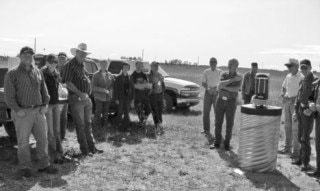By James Taylor
Black Press Staff
A group that included representatives from Ponoka County, the Grey Wooded Forage Association, the Medicine River Watershed Society and several environmentally-concerned individuals met last Thursday west of Rimbey to discuss and examine methods of reducing or eliminating harmful farming and ranching practices while increasing productivity.
“We’re teaming up with the Grey Wooded Forage Association for a pasture walk which entails trying to show producers how to get more out of their pasture including how they can read their pasture for forage density and carryover and making sure the cattle aren’t grazing the grass too far down,” said Shayne Steffen, Manager of Agricultural Services for Ponoka County.
In addition to touring several fields in the area, the group also discussed pasture management and ‘reading’ pastures to determine their health while also considering the impact of cattle production on the area’s rivers, creeks and watersheds.
“Primarily the pasture walk is for cattle producers but it also applies to horses, bison and other grazing animals,” Steffen said. “The site is right on the Medicine River and good management practices tell us that if you keep the cows out of the water, you have healthier water.”
During the tour innovative and cutting-edge farming practices were examined as well as identifying varies species of legumes, grasses and forbs. The group also visited the farm of Iain Aitken in the Last West Hall area who is trying to sustain his cowherd on pastures for most of the year.
Aitken is originally from Scotland and has found that grazing management practices are much different in Canada due, for the most part, to the change in climate. Steffen added that Aitken also made a recent discouvery that for all intents and purposes, may prove to be a very efficient way of ensuring healthy crop growth, at least initially.
“We may also be going over to another fellow’s place (Aitken) who has been feeding forage legume seed to his cows in their feed,” Steffen said. “And as they come out the other end, they’re already pre-fertilized and I guess he’s getting not a bad catch on it, so we’re hoping to see that too.”
Off-site watering and electric fencing were also topics of discussion during the tour which also included a demonstration from Jim Anderson of the Rimbey area who has designed and patented a devise known as Frost Free Nose Pumps whereby a cow or other grazing animal can access fresh water well away from rivers and streams despite the winter temperatures.
“Electric fencing is just another tool utilized for easy movement of cattle, for grazing purposes and also for keeping the cows out of the water to create a healthier watershed as well,” Steffen added.
He said that this is the first pasture walk of it’s kind in the County but added he plans on continuing with both the tours and promoting environmentally friendly farming practices.
“I just got here last year and we’re trying, as I can, to fit more conservation into the program here,” he said.
If anyone would like more information about the pasture walk or any of the other topics discussed, they are invited to contact Steffen at Ponoka County by calling 403-783-3333. He can also be reached via e-mail at: shsteffe@telus.net
